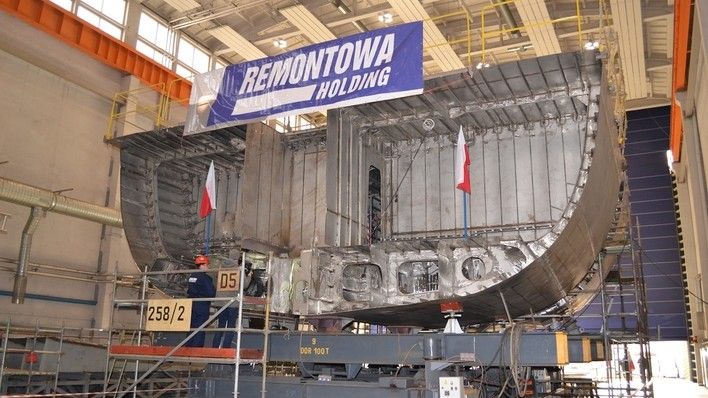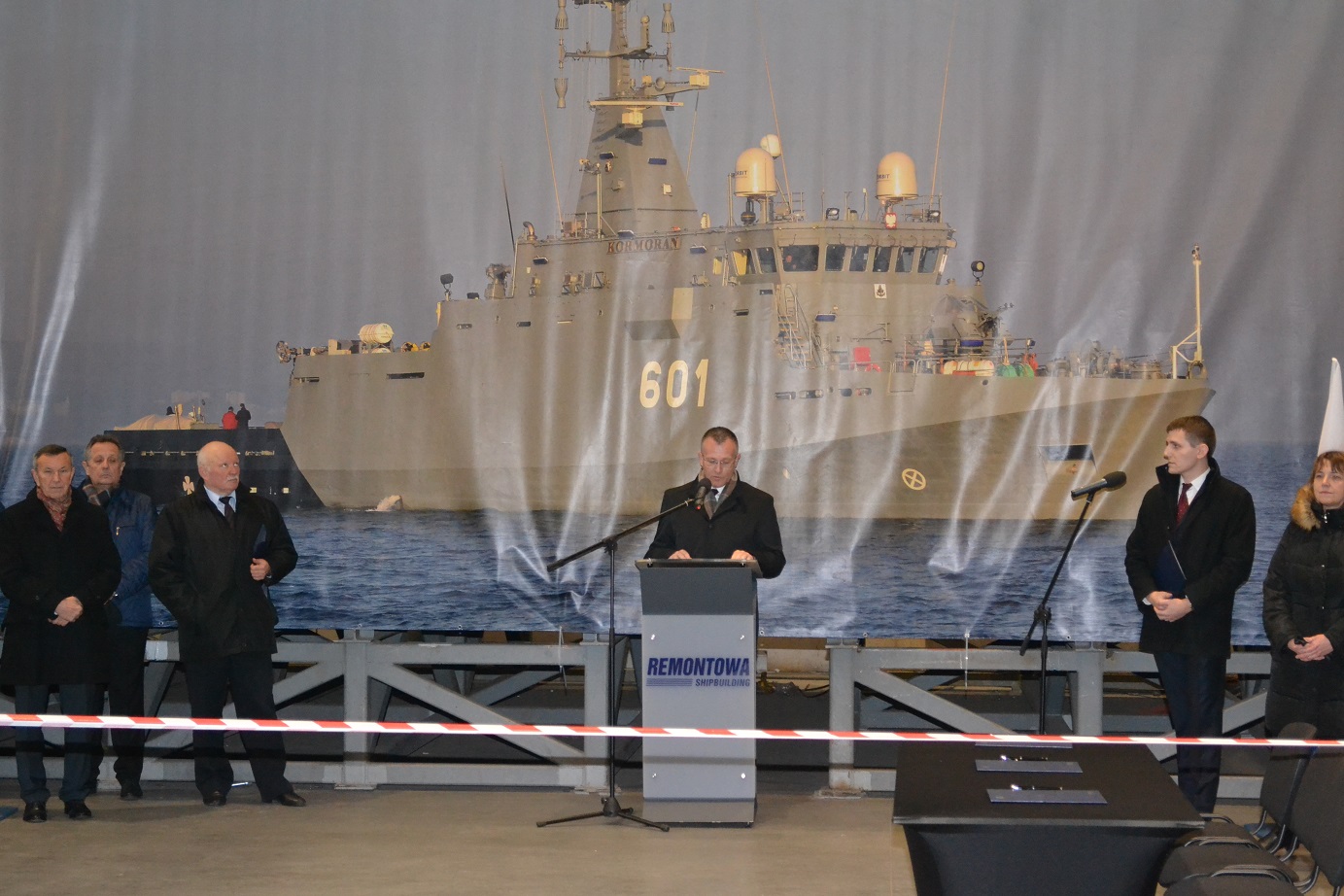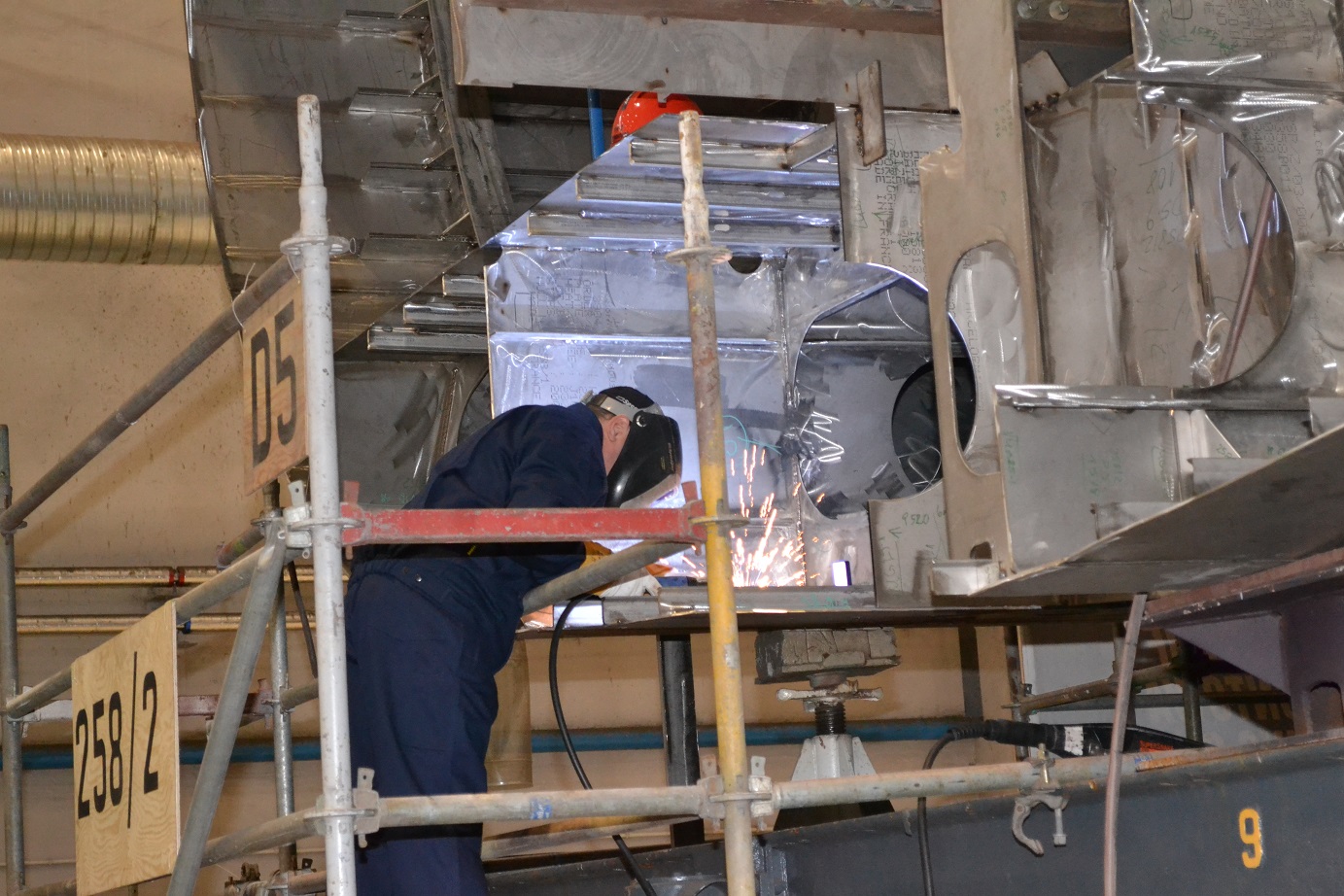“Albatros” Rising. Remontowa Holding’s Warships Programme Brought up to Speed

Remontowa Shipbuilding facility in Gdansk organized a keel-laying event for the ORP “Albatros” vessel, which is the second Kormoran II class MCMV (258 design). The building process progresses at a pace which is faster than initially assumed. This is a proof that well-managed Polish shipyard facilities are capable of carrying out work for the Polish Navy.
The keel-laying event concerning the “Albatros” MCMV was organized on 5th December 2018, at the Remontowa Shipbuilding shipyard. This was an event of a purely symbolic nature, since modern vessels feature no typical keel. The event organized in Gdansk concerned solely welding-in of a special commemorative medal within one of the bottom blocks of the hull of the new minehunter. We’re referring to a single block, since two modules as such were present within the production hall. Another two parts as such were prefabricated.
Furthermore, alongside the sections showcased, a high number of stored pre-cut structural elements was presented, made out of so called austenitic steel, making it possible to limit the magnetic signature of the new minehunters. These elements will soon be used to assemble further sections of the hull. The number of such semi-prefabricated elements may be surprising, since the first sheets were cut less than three months ago (for the “Albatros” MCMV). This happened on 18th September 2018.

The above also shows that no circumstances are present that would delay the handing off of Albatros to the Polish Navy. This has been scheduled to happen in January 2020. President of the Remontowa Shipbuilding yard clearly suggested that the work proceeds faster than it was initially planned. Thus, one may assume that assembly process concerning the third vessel in series - the ORP “Mewa” - is going to begin soon. This MCMV, on the other hand, is to be introduced into service by the end of 2021. The assembly hall where the “Albatros” is becoming an actual vessel is large enough to accommodate building process with another vessel of the class, even if a fully assembled hull of the Kormoran-class MCMV is placed alongside. Half of a complete hull would fit in the hall.
The event today also constitutes a confirmation of our organizational skills. The building process inaugurated today proceeds very well, and progresses quicker than scheduled.
This is a good example of how quick the vessels may be built, if procured in series. It is not all about shortening the programme as a whole. The cost of building is also lower. The ORP “Kormoran” class-defining ship is a prototype obviously - thus, extra funds were needed to conduct the research. However, series manufacturing shall always be perceived as more affordable, for instance thanks to lower prices in case of “wholesale” equipment orders.
The works on another two “Kormoran”-class vessels are not pursued solely by Remontowa Shipbuilding. It is a consortium effort, with the consortium involving, alongside Remontowa, OBR CTM S.A. and PGZ SW facilities, both based in Gdynia. A major portion of the equipment is delivered by subcontractors, including foreign companies. Despite the above, Remontowa Shipbuilding was able to coordinate the effort in case of the ORP “Kormoran”. All signs suggest that the scenario is going to repeat itself in case of the next two vessels.
However, the task is not going to be easier, as both “Mewa”, as well as “Albatros”, will need to be modified in line with the recommendations defined by the Navy, after 12 months of service of the first “258” design vessel. For instance, it is probable that the new MCMVs will not be fitted with the ZU-23-2MR “Wróbel” AAA solution. The new AM-35 35 mm gun is going to be used instead. The system is being currently tested on the ORP Kaszub ASW corvette. Most probably the intercom system will be replaced with a Polish solution developed by the KenBIT company.
Read More: 35 mm OSU (Vessel Armament System) Certified
Polish Industry and Complex Warship Tasks
The truth is that minehunters are not really placed among typical surface combatants. These vessels, however, carry out complex and dangerous tasks, and thus they are equipped with complex, costly and hardly integrable hardware. MCMVs as such, on the other hand, are a complex task to handle construction-wise at the design and building stage already. Thus, only a few shipyards around the world are able to cope with the process. Considering the above, the Kormoran II programme may be perceived as one of the most significant successes of the Polish shipbuilding recently.
Consortium involving Remontowa Shipbuilding had to face a task that would be even more difficult as the Polish Navy has prepared an expansive set of requirements. However, the task in question has been accomplished, and a vessel has been built, with equipment that no other MCMV around the world has at its disposal. The warship has been designed in Poland, completely, at the Remontowa Marine Design & Consulting bureau.
Due to the expansive set of assets onboard, the ORP “Kormoran” shall rather be perceived as a “minecruiser”, ready to carry out a wide range of minehunting activities:
- Searching for, identifying and acting against naval mines and other explosive ordnance and explosives;
- Securing and checking the nautical channels;
- Guiding vessels through waters where mine threat emerges.
Activities as such can be undertaken by Kormoran thanks to its design (non-magnetic steel hull and silent drive) and specialist equipment onboard fused into a single integrated SCOT-M combat management suite, developed by OBR CTM. Kormorans are going to be the only Polish vessels utilizing three types of sonars for the purpose of carrying out minehunting activities, along with four types of underwater vehicles, used for the purpose of detecting, locating and destroying the threats.
OBR CTM SHL-101/T under-keel sonar is the main sensor of the “Kormoran” vessel. This sensor makes it possible to scan the space under the vessel, but with a certain depth limitation. Thus, if the water body temperature is not making it possible to use the sonar (when the waves reflect from a layer of water without reaching the bottom) extra sonar is used, with that sonar having an ability to work deep underwater. The sonar may even work several hundred meters in front of the vessel. This system, known as SPVDS (Self Propelled Variable Depth Sonar), has been created around the Saab Double Eagle Mk III platform. Double Eagle Mk III has been used as the carerier for the TSM 2022 MkII sonar made in France.
The third type of sonar used by “Kormoran” has been integrated with the Kongsberg Hugin 1000 AUV. Hugin 1000 is a drone that allows for thorough mapping of the seabed. The system allows for autonomous operation away from the mothership for periods exceeding 35 hours. The system uses HISAS 1032 synthetic aperture side-looking sonar. This type of a system turned out to be useful in searching for the wreckage of the Argentinian ARA “San Juan” submarine.
Only after the level of complexity of the mine countermeasures has been assessed, and after the changes required to be introduced in the ship’s design have been introduced, one can realize how difficult the task of building a minehunter in Poland would be. In case of Remontowa Shipbuilding, this required a proper production hall to be established. A special, separate warehouse also had to be created, for the non-magnetic materials. ORP “Kormoran” is the first Polish vessel that features an austenitic hull.

The above required guaranteeing of specific manufacturing conditions, meaning that the hall shall be separated from the remaining portion of the shipyard, with a tight door and airlock, with an air-filtering system. All of the steps listed here are to prevent metal fillings from entering the areas of the shipyard where normal processing of black steel is taking place. Building a Polish MCMV also required proper internal equipment (cabinets), tools and clothing for the workers.
Kormoran vessels are placed on steel supports (tracks and carts for instance), however separation is always ensured, for instance by wooden or plastic elements, or other non-magnetic materials. In this way, the material is isolated from any magnetic deposits. These deposits cannot be eliminated completely - which is obvious - however, thanks to rigid discipline adopted throughout the manufacturing cycle, the ferrite influence on the degaussed material of the hull of the vessel and of its components may be limited.
Remontowa Shipbuilding also had to prepare a proper storage area for the concession-based products (for which concession is required, in order to be able to conduct manufacturing and trading activities) as well as for the non-magnetic materials (including the austenitic steel). For that purpose, one of the halls has been used (passage no. 4 of the C209 building). This portion of the hall has been separated with a special wall from the rest, it also received a proper set of equipment.
Remontowa Shipbuilding has also mastered the technology of building vessels made out of austenitic steel. This type of steel is more rigid than the standard warship-building materials, however it requires a special and difficult processing technology to be applied, in order to connect the sheets and weld them. However, the shipyard managed to train the required number of welders, and metalworkers, with individual credentials issued to them. These experts remain ready to face the future challenges, as the shipyard does as well - the facility is working on two orders concerning entirely new vessels for the Navy now. Six tugboats for the Polish Navy are being built in parallel to the MCMV. The tugboats are going to be delivered on the basis of PLN 283.5 million worth contract signed on 19th June 2017.
What’s next for the “Albatros” MCMV?
“Albatros” is being built at the Remontowa Shipbuilding facility on the basis of agreement signed in December 2017. The contract concerned building of two MCMVs (pricetag of PLN 1.1 billion) and securing of three logistics support packages (one package has already been provided for the ORP “Kormoran” MCMV that is already in service).
The second vessel of the class is to become a part of the 13th Minesweeper Squadron of the 8th Coastal Defence Flotilla. So far, Albatros has no crew. Navy Cpt. Piotr Gorycki is expected to become the commander of the vessel. So called skeleton crew is going to be assembled as well. The crewmembers will, in the future, provide assistance in the process of fitting the hull with proper equipment. The training of the sailors will not be difficult, as the first vessel of the class, the ORP “Kormoran” has reached the FOC status, and thus it may be utilized, initially, as a training platform.
Kormoran’s crew has been operating the vessel for a year now. Furthermore it has gone thorough a two-weeks intensive training at the German Navy’s training centre in Neustadt (Damage Control Training). There, safety procedures and minehunting activities were the subject of the training conducted. Thus, no delays should occur when it comes to training and no problems are expected.
Kormoran MCMVs are a good example of the ability the Polish shipyards have, within the scope of building warships. Furthermore, it should be noted that if the vessels are procured in series, then cost and time to build will be very much diminished, thanks to approach as such. However, the above requires decisive steps to be taken by the MoD.
Apart from the representatives of the consortium (Remontowa Shipbuildin management, OBR CTM, PGZ SW), collaborating companies and the Polish Register of Shipping, the keel-laying event also involved representatives of the National Security Bureau (Deputy Head at the National Security Bureau - Dariusz Gwizdała and Director of the Armed Forces’ Leadership at the National Security Bureau, Brig. general Jarosław Kraszewski), and of the Navy (including the head of the Maritime Management, Deputy Navy Inspector, rear admiral Krzysztof Zdonek).
The MoD should exhibit vivid interest in the Kormoran programme - not only within the scope of its completion, but also when it comes to promoting it. Theres are numerous countries interested in procuring modern MCMVs and all steps need to be taken to promote the Polish vessel on the foreign markets. A good opportunity to do so will emerge during the DSEI 2019 event in London, scheduled to happen between 10th and 13th September. If the visitors will be given a chance to get acquainted with vessels at the Royal Victoria Dock, such as the INS “Trikand” frigate or Irish “Samuel Beckett” Róisín-class patrol vessel, as it happened during the recent editions of the event then Kormoran MCMV could also be showcased in London. The fact that Remontowa Shipbuilding is a privately owned enterprise shall be disregarded here, since state entities were also involved in building the Kormoran-class warships - including the OBR CTM S.A. entity belonging to PGZ.
It is all about promoting the Polish shipbuilding industry abroad. This is how other countries proceed. And Poland should follow in their footsteps.
